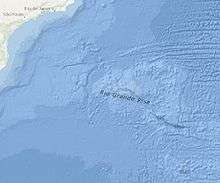Rio Grande Rise
The Rio Grande Rise, also called the Rio Grande Elevation, is an aseismic ocean ridge in the southern Atlantic Ocean off the coast of Brazil. Together with the Walvis Ridge off Africa, the Rio Grande Rise forms a V-shaped structure of mirrored hotspot tracks or seamount chains across the northern South Atlantic.[2] In 2013, Brazilian scientists announced that they found granite boulders on the Rio Grande Rise and speculated that it could be the remains of a submerged continent, which they called the "Brazilian Atlantis".[3] Other researchers, however, noted that such boulders can end-up on the ocean floor by less speculative means.[4]

Geology
The Rio Grande Rise separates the Santos and Pelotas Basins and is composed of western and eastern areas, which have different geological backgrounds. The western area has numerous guyots and seamounts and a basement dated to 80 to 87 million years ago. The eastern area is covered by fracture zones and may represent an abandoned spreading centre. In the western area, volcanic breccia and layers of ash indicate widespread volcanism during the Eocene, which coincides with the formation of volcanic rocks onshore. During this period, parts of the western plateau were uplifted over sea level and short-lived volcanic islands formed.[5]
When West Gondwana (i.e. South America) broke away from Africa during the Early Cretaceous (146 to 100 Ma), the South Atlantic opened up from its southern to its northern end. In this process, the voluminous Paraná and Etendeka continental flood basalts formed in what is now Brazil and Namibia. This event is linked to the Tristan-Gough hotspot, now located near the Mid-Atlantic Ridge, close to Tristan da Cunha and the Gough Islands. During the Maastrichtian (60 Ma), the orientation of spreading changed, which is still visible on the African side, and volcanism ended on the American side. This process resulted in the Tristan-Gough seamount chains on either side of the Tristan-Gough hotspot.[5]
Palaeoclimatic role
A Brazilian-Japanese expedition in 2013 recovered in situ granitic and metamorphic rocks on the Rio Grande Rise. This can possibly indicate that the plateau includes fragments of continental crust — possible remains of micro-continents similar to those found on and around Kerguelen in the Indian Ocean and Jan Mayen in the Arctic Ocean. The existence of such microcontinents is speculative, however, since their remains tend to be covered by younger layers of lava and sediments.[5] Nevertheless, transoceanic dispersals are hinted at by the fossil record of, for example, flightless birds such as Lavocatavis, indicating that several islands between Africa and South America made island hopping possible across the Atlantic during the Tertiary (66 to 2.58 Ma).[6]
At the beginning of the Maastrichtian, the characteristics of water masses differed north and south of the Rio Grande Rice-Walvis Ridge complex. The disappearance of these differences during the Maastritchtian indicates a reorganisation of oceanic circulation patterns that lead to a global homogenisation of intermediate and deep waters. This process seems to have been triggered by the breaching of the Rio Grande Rise-Walvis Ridge complex and the disappearance of epicontinental seaways such as the Tethys Ocean. The process resulted in the deterioration of rudist-dominated tropical habitats and consequently the extinction of benthic inoceramid bivalves.[7]
The origin of modern circulation of cold, deep water — known as the "Big Flush" — is associated with Early Eocene (55 to 40 Ma) geological events; tectonism that resulted in the opening of the north-east Atlantic and fracture zones that developed in the subsiding Rio Grande Rise, which allowed cold water from the Antarctic Weddell Sea to flow northward into the North Atlantic. 40 Ma, the generation of cold bottom water in the Antarctic resulted in the formation of psychrospheric fauna, which today live in temperatures below 10 °C (50 °F), in the Atlantic and Tethys. This global distribution suggests that the Rio Grande Rise had been breached by this time, allowing cold, dense water to move north-south through a corridor enhancing the transition from a latitudinal thermospheric circulation to a meridional thermohaline circulation.[8]
References
Notes
- Zenk & Morozov 2007, Fig. 1
- O'Connor & Duncan 1990, Introduction, p. 17475
- Bowater, Donna (2013-05-07). "Brazilian 'Atlantis' found".
- National Geographic News 2013
- Sager 2014, pp. 2–4
- Mourer-Chauviré et al. 2011, Abstract
- Frank & Arthur 1999, Conclusions, p.115
- Berggren 1982, Cenozoic, pp. 122-123
Sources
- Berggren, W. A. (1982). "Role of ocean gateways in climatic change" (PDF, 25 Mb). In Berger, W. H.; Crowell, J. C (eds.). Climate in Earth History. Studies in Geophysics. Washington D.C.: National Academy Press. pp. 118–125. Retrieved 17 May 2015.
- Frank, T. D.; Arthur, M. A. (1999). "Tectonic forcings of Maastrichtian ocean‐climate evolution". Paleoceanography. 14 (2): 103–117. Bibcode:1999PalOc..14..103F. doi:10.1029/1998PA900017.
- Mourer-Chauviré, C.; Tabuce, R.; Mahboubi, M.; Adaci, M.; Bensalah, M. (2011). "A Phororhacoid bird from the Eocene of Africa". Naturwissenschaften. 98 (10): 815–823. Bibcode:2011NW.....98..815M. doi:10.1007/s00114-011-0829-5. PMID 21874523.
- O'Connor, J. M.; Duncan, R. A. (1990). "Evolution of the Walvis Ridge‐Rio Grande Rise Hot Spot System: Implications for African and South American Plate motions over plumes" (PDF). Journal of Geophysical Research: Solid Earth. 95 (B11): 17475–17502. Bibcode:1990JGR....9517475O. doi:10.1029/jb095ib11p17475. Retrieved 16 May 2015.
- Sager, W. W. (2014). "Scientific Drilling in the South Atlantic: Rio Grande Rise, Walvis Ridge and surrounding areas" (PDF). U.S. Science Support Program Workshop Report. Retrieved 16 May 2015.
- Than, Ken (May 11, 2013). "Lost Land Found by Scientists". National Geographic News. Retrieved 17 June 2015.
- Zenk, W.; Morozov, E. (2007). "Decadal warming of the coldest Antarctic Bottom Water flow through the Vema Channel" (PDF). Geophys. Res. Lett. 34 (14): L14607. Bibcode:2007GeoRL..3414607Z. doi:10.1029/2007GL030340.